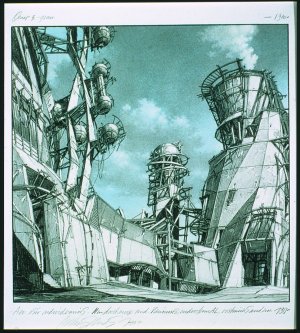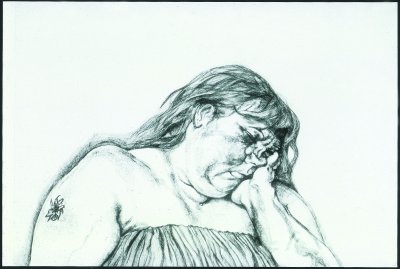
Aluminum by Design: Jewelry to Jets
October 29, 2000 – February 11, 2001
Get Ready for the Metal of the Future
The appropriation
of technologies and materials from other industries is common in the design
world. Ron Arad, architect and professor of industrial and furniture
design at the Royal College of Art in London, was inspired to create this
prototype version, Un-cut, of his Tom Vac chair by what hangs in his kitchen.
In his case, what hangs in his kitchen is an aluminum airplane wing.
When Arad was asked to create a temporary landmark in Milan to promote
the design magazine Domus, he created a sculpture of one hundred stacking
chairs of vacuum-formed aluminum, manufactured by the same company that
made his airplane wing. Un-cut is the untrimmed aluminum prototype.
Paco Rabanne rejected the notion that fabric
was the only material suitable for clothing and in 1966 first ordered aluminum
disks from a company that made protective aprons for industrial use.
His 1999/2000 couture collection includes several aluminum dresses as well.
While metal armor is nothing new, Rabanne’s reinterpretation takes the
idea of chain mail from the battlefield to the catwalk, finding beauty
in what had been strictly utilitarian.
Marc Newson’s Lockheed Lounge is based
on his vision of a “fluid metallic form, like a giant blob of mercury.”
The chair’s fiberglass body is covered with thin aluminum sheets joined
with blind rivets, giving the impression of an airplane fuselage.
The Lounge secured a place in popular culture when it appeared in Madonna’s
Rain video in 1988 and Philippe Starck integrated it into the 1990 redesign
of the Paramount Hotel in New York.
These objects and many more can be seen
in Aluminum by Design: Jewelry to Jets. Organized by Carnegie Museum of
Art, this major international loan exhibition is the first to explore how
aluminum has inspired creativity and innovation in design in the last 150
years.
Aluminum By Design: Jewelry to
Jets is made possible by the generous sponsorship of Alcoa Foundation.
Significant support has also been provided
by Audi of America, Inc.
Additional major support has been provided
by The Roy A. Hunt Foundation, The Arthur Vining Davis Foundations, and
the Commonwealth of Pennsylvania.
Funding has also been provided by Perfido
Weiskopf Architects.

Inside Out: New Perspectives on the Heinz
Architectural Center’s Collection
October 28, 2000 – January 21, 2001
When the Heinz Architectural Center re-opens
after extensive renovation, the space available for exhibitions will have
increased by forty percent. The additional gallery will be a single
large room that permits bigger installations, gives the curators more flexibility
by providing for insertion of temporary walls and other exhibition-specific
elements, and accommodates technology-based representations of architecture.
To introduce and celebrate the new space, curator Joseph Rosa and associate
curator Tracy Myers have organized an exhibition of highlights from the
collection--many previously not shown.
“This exhibition will be about relationships
between objects," explains Rosa, "rather than a chronological look at what
we have, in order to illustrate the nuances and influences among the various
media of architectural drawings and models.” The Center’s collection
surveys primarily the 19th and 20th centuries; purchases in the past two
years have focused on the work of current practitioners. Organizing
this exhibition has given Rosa and Myers the opportunity to show the Center’s
newest acquisitions and to take a fresh look at its works on paper, models,
rare books, and photographs, drawing unexpected connections among them.
The exhibition includes works by Giovanni
Battista Piranesi, A.J. Davis, Paul Philippe Cret, J.J.P. Oud, Harrison
& Abramovitz, Lebbeus Woods, Bernard Tschumi, and Lauretta Vinciarelli.

Lucien Freud: Etchings from the PaineWebber
Art Collection
Forum Gallery, October 28, 2000 – January
21, 2001
Lucien Freud entered a private art school
in London at the age of 16, accidentally burned it down, and ran off to
sea. When he returned to London two years later with some drawings
published in the magazine Horizon, he was welcomed back at the school.
Maybe it was his handsomeness, his charming manners, or his numerous royal
awards, but he has become, according to cultural commentator Marina Warner,
“a figure of popular myth, an artist poised between the underworld and
the aristocracy, a kind of slumming Faust who prowls lowlife pubs and eats
woodcock for breakfast.”
The son of architect Ernst Freud and the
grandson of Sigmund Freud, Lucien Freud was born in Berlin in 1922.
Known primarily as a painter, he began to produce etchings in 1946 and
then turned his back on the medium until 1982. That year he made a few
etchings for inclusion in a monograph on his work. While the prints
had to be small to fit in the book, writes Scott Wilcox, exhibition curator
and curator of prints and drawings at Yale Center for British Arts,
the size “imparts a sense of intimacy, accentuated by the crowding of facial
features into the small box defined by the plate.”
Freud’s technically proficient works detail
heavy limbs, drooping breasts, and the conflicting planes in the human
face. “As difficult to like as they are to ignore,” writes David
Cohen in the exhibition catalogue, these etchings convey the sensation
of seeing the familiar human figure for the very first time.
The exhibition, organized by the Yale Center
of British Art, is made possible by PaineWebber Group Inc.
|

